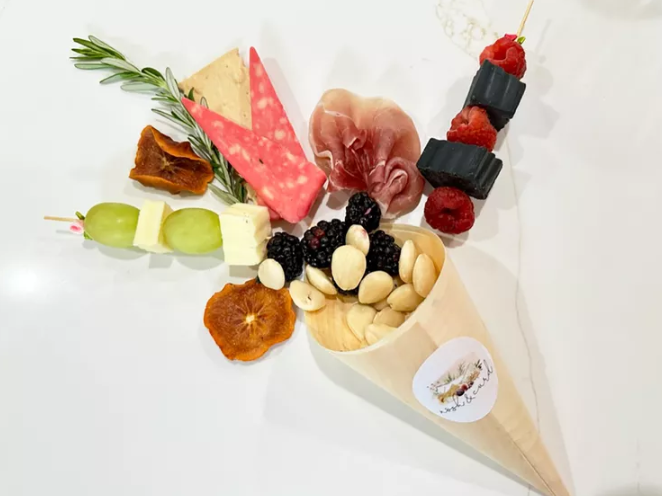
Introduction: Indulging in the flavors of Italy doesn’t always mean cooking up complex dishes. Sometimes, the simplest combinations can transport you to the sun-soaked hills of Tuscany or the bustling streets of Rome. One such culinary delight is the antipasto platter—a vibrant array of olives, cheese, and cured meats that tantalizes the taste buds and ignites the appetite. Whether you’re hosting a casual gathering, a sophisticated soirée, or simply craving a taste of Mediterranean goodness, crafting your own antipasto platter is both effortless and rewarding. Let’s delve into the art of assembling this classic Italian appetizer, elevating it with SEO-friendly ingredients and instructions to ensure your culinary creation not only delights the palate but also attracts attention online.
Ingredients:
- Assorted Olives: Select a variety of olives such as Kalamata, Castelvetrano, and Cerignola for a mix of flavors and colors.
- Cheese Selection: Opt for a diverse cheese spread, including Parmigiano-Reggiano, Pecorino Romano, Mozzarella, and Gorgonzola.
- Cured Meats: Choose high-quality cured meats like Prosciutto di Parma, Salami Milano, Capocollo, and Bresaola.
- Marinated Vegetables: Enhance the platter with marinated artichoke hearts, roasted peppers, and sun-dried tomatoes.
- Nuts and Fruits: Add a crunch with almonds, walnuts, or pistachios, and include fresh or dried fruits such as figs, grapes, or apricots.
- Bread or Crackers: Serve a selection of rustic bread slices, breadsticks, or crackers as a base for the antipasto.
Instructions:
- Prepare the Ingredients: Begin by arranging your ingredients in separate bowls or platters. Rinse the olives to remove excess brine and drain them well. Slice the cheeses and cured meats into bite-sized portions, ensuring they are easy to pick up and enjoy. If using marinated vegetables, drain any excess liquid and pat them dry with paper towels to prevent the platter from becoming too watery.
- Assemble the Platter: Select a large serving platter or wooden board as the canvas for your antipasto masterpiece. Start by placing the cheeses evenly around the platter, creating a visually appealing arrangement. Next, add the cured meats, folding or rolling them for an elegant presentation. Fill in the gaps with the assorted olives, nestling them between the cheeses and meats. Scatter the marinated vegetables, nuts, and fruits throughout the platter, ensuring a balanced distribution of flavors and textures.
- Garnish and Serve: To elevate the presentation further, garnish the antipasto platter with fresh herbs such as basil, rosemary, or thyme. Drizzle a touch of extra virgin olive oil over the cheeses and meats for added richness. Serve alongside freshly baked bread or crackers, inviting guests to assemble their own flavorful combinations. Encourage exploration and experimentation with different pairings, allowing each bite to be a journey through the vibrant tastes of Italy.
Crafting an antipasto platter is not only a culinary endeavor but also an opportunity to showcase your creativity and passion for food. With a carefully curated selection of ingredients and thoughtful presentation, your antipasto platter is sure to be a feast for the senses, enticing both the palate and the camera lens. Capture the essence of Italian gastronomy and share your culinary masterpiece with friends, family, and followers alike, spreading joy and inspiration one delicious bite at a time.
Serving Tips:
- Temperature Matters: Take your antipasto ingredients out of the refrigerator about 30 minutes before serving to allow the flavors to fully develop and the cheeses to reach their ideal serving temperature. Cold temperatures can dull the flavors, so a slightly warmer presentation enhances the taste experience.
- Create a Visual Feast: Presentation is key when serving an antipasto platter. Arrange the ingredients in a visually appealing manner, grouping similar items together and creating contrast with colors and textures. Use fresh herbs or edible flowers as garnishes to add a pop of color and freshness to the platter.
- Pair with Complementary Beverages: Serve your antipasto platter with a selection of beverages that complement the flavors. Italian wines such as Chianti, Prosecco, or Pinot Grigio are classic choices, but you can also offer craft beers, sparkling water, or fruity cocktails for variety. Provide tasting notes or recommendations to guide guests in their beverage choices.
- Offer Accompaniments: Enhance the antipasto experience by providing accompaniments such as flavored olive oils, balsamic vinegar, or honey for drizzling over the cheeses and meats. Include a variety of bread options, from crusty baguettes to crunchy breadsticks, to soak up the flavorful oils and juices from the platter.
- Encourage Exploration: Invite guests to explore the flavors and textures of the antipasto platter by sampling different combinations of ingredients. Provide small plates and cocktail picks for easy serving, allowing guests to create their own personalized bites. Foster conversation by sharing the origins and characteristics of each ingredient, sparking culinary curiosity and appreciation.
Storage Tips:
- Wrap and Refrigerate: After serving, promptly wrap any leftover cheeses and cured meats in plastic wrap or wax paper to prevent them from drying out in the refrigerator. Store them separately from the olives and marinated vegetables to maintain their individual flavors and prevent cross-contamination.
- Keep Cool and Dry: Store the wrapped ingredients in the refrigerator at a temperature between 35°F and 40°F (1.6°C to 4.4°C) to ensure freshness and food safety. Avoid placing the antipasto platter in the coldest part of the refrigerator, as extreme cold can affect the texture and flavor of certain cheeses and meats.
- Consume Within a Few Days: While antipasto ingredients can last several days when properly stored, it’s best to consume them within 2-3 days for optimal freshness and flavor. Check for any signs of spoilage such as mold or off odors before consuming leftovers, and discard any items that appear questionable.
- Cover to Preserve Flavor: To prevent the flavors of the cheeses and meats from transferring to other foods in the refrigerator, cover the wrapped ingredients with an additional layer of aluminum foil or place them in a sealed container. This also helps maintain the integrity of the flavors and prevents them from absorbing unwanted odors.
- Rejuvenate Before Serving: When ready to enjoy the leftovers, take the cheeses and cured meats out of the refrigerator 30 minutes before serving to allow them to come to room temperature and regain their full flavor and texture. Refresh any wilted herbs or garnishes with a quick rinse under cold water and pat them dry before using them to garnish the platter.
Variations:
- Mediterranean Twist: Add a Mediterranean flair to your antipasto platter by incorporating ingredients like marinated artichoke hearts, roasted garlic cloves, stuffed grape leaves, and hummus. Serve with pita bread or grilled flatbread for a delightful fusion of flavors.
- Seafood Selection: Elevate your antipasto platter with a selection of seafood delicacies such as smoked salmon, anchovies, marinated shrimp, and grilled calamari. Accompany these with lemon wedges, capers, and seafood sauce for a refreshing and indulgent experience.
- Vegetarian Delight: Create a vegetarian-friendly antipasto platter by focusing on an assortment of roasted vegetables, grilled tofu, marinated mushrooms, and creamy goat cheese. Include dips like tzatziki or roasted red pepper hummus for added variety and serve with crusty bread or gluten-free crackers.
- Fruit Infusion: Infuse your antipasto platter with the sweetness of fresh fruits such as sliced apples, pears, strawberries, or melon balls. Pair these with creamy cheeses like brie or goat cheese, as well as honey, fig jam, or fruit compote for a delightful contrast of flavors.
- Global Inspirations: Take inspiration from global cuisines to create a diverse antipasto platter. Incorporate ingredients like Spanish chorizo, Greek feta cheese, Middle Eastern falafel, Indian chutneys, and Japanese pickled vegetables for a worldly culinary experience that delights the senses.
Experiment with different combinations of ingredients, flavors, and textures to customize your antipasto platter according to personal preferences and dietary restrictions. Whether you’re exploring traditional Italian flavors or embarking on a culinary adventure around the globe, there’s no limit to the creative variations you can explore with this versatile appetizer.
FAQs:
- Can I prepare the antipasto platter in advance? Yes, you can prepare many components of the antipasto platter in advance. Cheeses, cured meats, and marinated vegetables can be sliced and arranged on the platter several hours before serving. However, it’s best to wait until closer to serving time to add items like fresh fruits and bread to ensure they remain fresh and flavorful.
- How do I choose the best quality ingredients for my antipasto platter? When selecting ingredients for your antipasto platter, opt for high-quality, artisanal products whenever possible. Look for cheeses and cured meats from reputable producers, and choose olives and marinated vegetables that are fresh and flavorful. Visit specialty food stores or local markets to find unique and authentic ingredients that will elevate your platter.
- How do I accommodate dietary restrictions for guests? To accommodate dietary restrictions, consider offering a variety of options on your antipasto platter. Include a mix of cheeses, cured meats, and vegetables to cater to different preferences and dietary needs. Label any items that contain common allergens such as nuts or dairy, and provide alternative options for guests with specific dietary requirements, such as gluten-free crackers or vegan cheese alternatives.
- How much should I prepare per person for an antipasto platter? As a general rule of thumb, plan for approximately 2-3 ounces of cheese and cured meat per person when serving an antipasto platter as an appetizer. For olives, marinated vegetables, and other accompaniments, aim for 1-2 ounces per person. Adjust the quantities based on the size of your gathering and whether the antipasto platter is the main focus of the meal or part of a larger spread.
- How long can I leave the antipasto platter out at room temperature? It’s best to serve the antipasto platter within 2 hours of assembling it and to refrigerate any leftovers promptly. If you’re hosting a party or event where the platter will be out for an extended period, consider serving it on a chilled platter or placing it on a bed of ice to keep the ingredients fresh and safe to eat. Avoid leaving perishable items like cheese and cured meats at room temperature for more than 2 hours to reduce the risk of foodborne illness.
Conclusion:
Crafting an antipasto platter is more than just assembling a selection of ingredients—it’s a culinary journey that celebrates the vibrant flavors and rich traditions of Italian cuisine. Whether you’re hosting a gathering with friends and family or simply treating yourself to a taste of Mediterranean indulgence, the art of the antipasto platter offers endless possibilities for creativity and exploration.
From the savory richness of aged cheeses and cured meats to the briny tang of marinated olives and vegetables, each component of the antipasto platter tells a story of craftsmanship and culinary expertise. By carefully selecting high-quality ingredients, thoughtfully arranging them on a platter, and serving with flair and hospitality, you can transform a simple appetizer into a memorable dining experience that delights the senses and brings people together.
As you embark on your own antipasto adventure, remember to embrace experimentation and customization, allowing your personal tastes and preferences to guide you. Whether you opt for a classic combination of olives, cheese, and cured meats or explore innovative variations inspired by global flavors, the beauty of the antipasto platter lies in its versatility and adaptability to any occasion.
